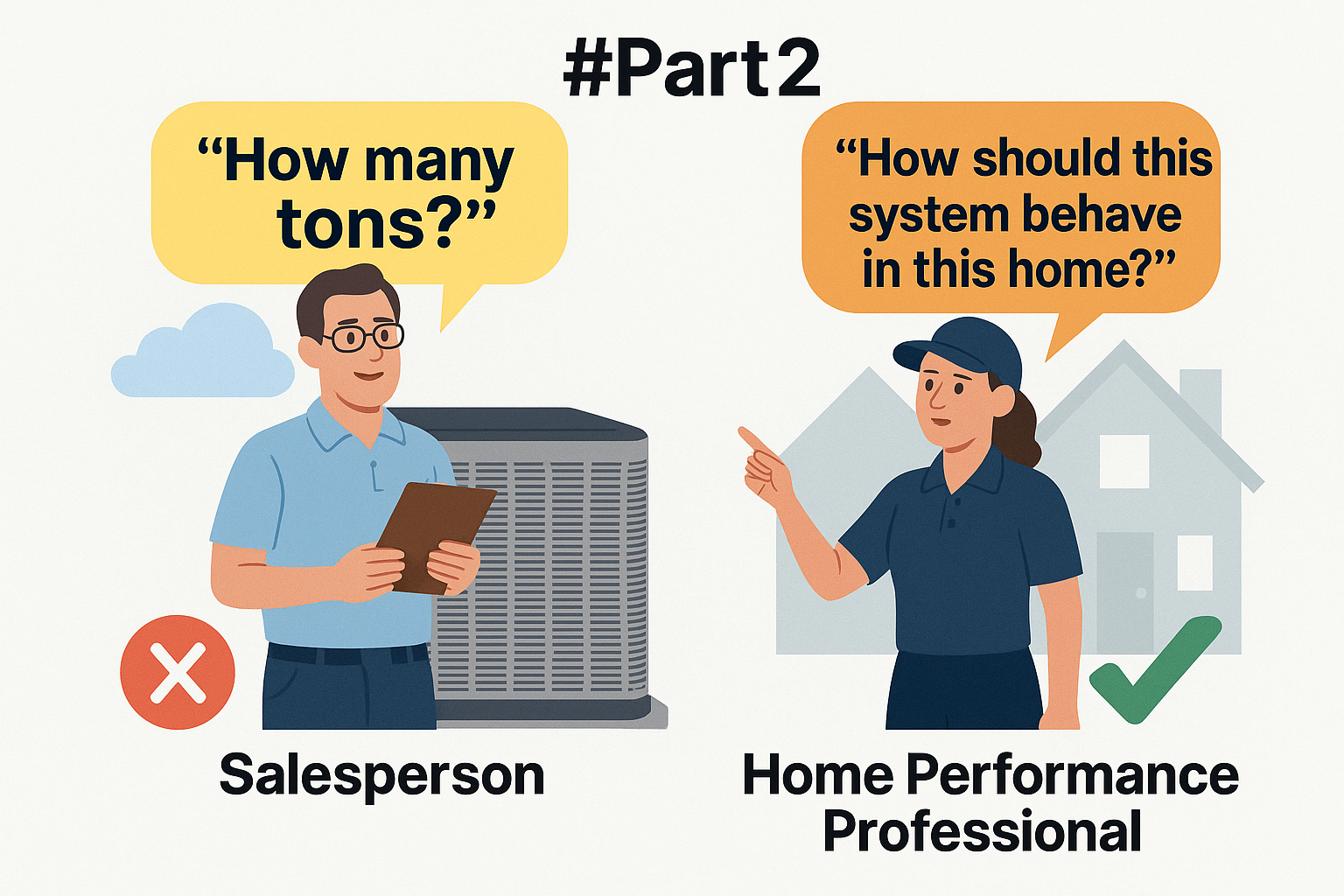
Need Help Navigating Manual S 2024 Sizing Logic?
Whether you're a contractor, rater, or builder, we're here to help you:
Select heat pumps that actually match the load — not just the tonnage
Document compliance using expanded performance data
Integrate dehumidifiers the right way and stay compliant
Train your sales team to lead with trust, not just tonnage
------------- Book a free Manual S compliance review or training demo — and let's make sure your next install delivers what was promised.
Part 2 of the “Permanent Load Reduction Specialists Are Really Agents of Change” Series
By Jeremy Begley, Founding Shareholder – HVAC 2 Home Performance
Most contractors are still sizing systems like it’s 2005. They lean on AHRI numbers, old rules of thumb, or whatever their supplier has on the truck. Then they’re shocked when the install underperforms—short cycles, high humidity, or emergency heat kicking in on mild days.
Manual S 2024 changed that. It made one thing crystal clear:
You must match the load. Not in theory. In reality. With data.
And that starts with recognizing the full load profile, including the most overlooked component: latent.
The New Rule: Match the Right Parts of the Load
Manual S now breaks the cooling load into three specific categories:
Sensible (temperature or dry bulb)
Latent (moisture)
Total (sensible + latent)
And here’s the core requirement:
Latent load must always be fully addressed — 100% — by either the cooling system or a combination of cooling plus dehumidification. Sensible and total capacity must be validated using OEM expanded performance data at your actual design conditions.
This requirement applies regardless of:
Equipment type (single-stage, two-stage, inverter)
Whether or not you’re using a supplemental dehumidifier
Manual S Sizing Guidance by Equipment Type
Here’s a simplified breakdown of the approved sizing ranges from Manual S 2024 — with and without a dehumidifier:
Single-Stage Equipment
Without Dehumidifier
Latent: 100% (no exceptions)
Sensible: 90% to 110%
Total: 95% to 115%
With Dedicated Dehumidifier
Latent: System must cover at least 60%; dehu may cover the rest
Sensible: 90% to 110%
Total: 90% to 115%
You must document the dehumidifier’s rated latent capacity. “Just adding a dehu” doesn’t get you out of sizing compliance.
Two-Stage Equipment
Without Dehumidifier
Latent: 100%
Sensible: 85% to 110%
Total: 90% to 115%
With Dehumidifier
Latent: Minimum 60% from the system
Sensible: 85% to 110%
Total: 90% to 115%
Use low-stage output to confirm coverage during part-load conditions — especially during spring/fall shoulder seasons where humidity control matters most.
Variable-Speed (Inverter) Equipment
Without Dehumidifier
Latent: 100%
Sensible: 80% to 110%
Total: 85% to 115%
With Dehumidifier
Latent: Minimum 60%
Sensible: 80% to 110%
Total: 85% to 115%
Use OEM expanded data or NEEP performance listings to verify both maximum and minimum operating capacities. Oversized inverter systems are still a risk—especially if they can’t turn down low enough to dehumidify effectively in milder weather.
Pro Tips for Staying Compliant (and Profitable)
1. Match latent first
If you don’t cover the full latent load (with or without a dehumidifier), the system may fail to control humidity, especially in high-performance homes.
2. Use expanded performance data, not AHRI ratings
You need sensible, latent, and total capacity at your exact design conditions. No shortcuts.
3. Document your math
Manual S requires written justification of sizing factors, load breakdowns, and equipment matches — including any dehu contribution.
4. Validate inverter turn-down
Don’t just match peak load — verify that your inverter system can modulate down far enough to stay in comfort range without short cycling.
5. Trust, not tonnage
A "3-ton" system might deliver 43,000 Btuh at 95°F or just 28,000 at 5°F. Know what your client is actually getting at their house.
6. Dehumidifier Contribution is Real, but Must Be Documented
If you’re using a dedicated dehumidifier, Manual S allows you to reduce the latent load requirement on the cooling system — but only up to the rated capacity of the dehumidifier.
From Addendum C, Section C-3.2:
"If a dedicated dehumidifier is installed and contributes to latent moisture removal, the Rater/Designer may reduce the latent component of the load used for cooling equipment sizing. This reduction must not exceed the dehumidifier’s rated capacity under expected conditions and must be documented in the sizing justification."
This Isn’t About Sizing Units — It’s About Defending Results
Permanent Load Reduction Specialists — the people selling and commissioning heat pumps the right way — aren’t out here guessing. They’re:
Verifying expanded performance data
Accounting for humidity load with or without a dehu
Delivering comfort, not callbacks
Matching systems to homes — not to outdated “rules of thumb”
That’s not just good HVAC. That’s leadership.
Note: This blog references content from Manual S 2024 and proposed Addendum C (2025). Manual J 2024 is still under revision and has not been permanently published as of this writing.
